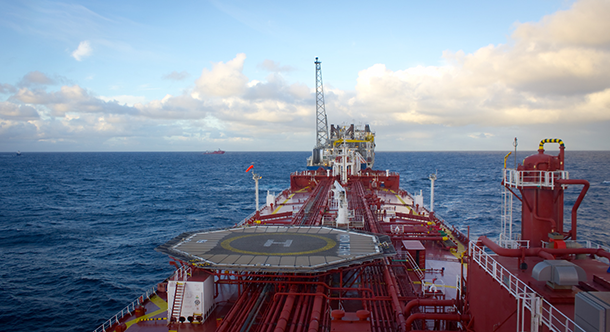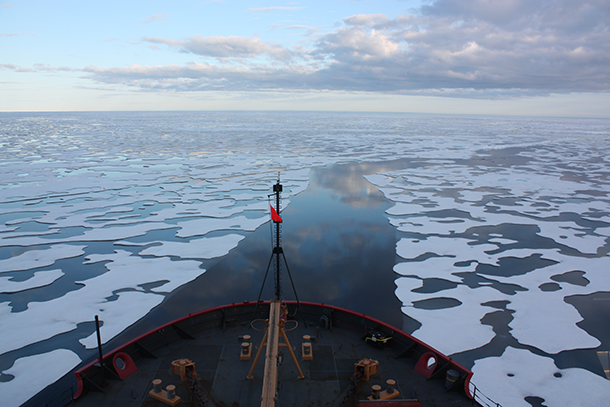Exxon Denied its Own Climate Research
Air Date: Week of October 23, 2015

In 1978, Exxon equipped one of its supertankers—the Esso Atlantic—with instruments for measuring carbon dioxide in the air and water along the tanker’s route from the Gulf of Mexico to the Persian Gulf. (Photo: Jon Olav Eikenes, Flickr CC BY 2.0)
Investigations by InsideClimate News and the Los Angeles Times reveal that Exxon’s scientists and top management, informed by the company’s own ambitious climate research, had grasped the import of climate change by the early 1980s. ICN reporter Neela Banerjee tells host Steve Curwood how they discovered the research and how top Exxon management nevertheless cast doubt on the facts of global warming, starting in the late 1990s.
Transcript
CURWOOD: From the Jennifer and Ted Stanley Studios at the University of Massachusetts Boston and PRI, this is Living on Earth. I’m Steve Curwood. Investigative reporting by InsideClimate News and the Los Angeles Times alleges that Exxon was at the cutting edge of climate change research in the late 70s and early 80s, and understood that burning fossil fuels would warm the planet in destructive ways. But the reporting also found Exxon later worked to seed doubt on the climate science and funded climate-denying organizations. Neela Banerjee is one of the lead reporters on the six-part InsideClimate News investigation. Neela, welcome to Living on Earth.
BANERJEE: Thank you for having me.
CURWOOD: So this is quite an investigation, eight months long, I gather. Take us back to where you started.
BANERJEE: We started looking into early climate research by academics and the federal government here in the United States, and in the process of looking at what those people were doing, we found out that scientists from Exxon had peer-reviewed research accepted in journals in the early 1980s. So that piqued our interest because a lot of us know the history of Exxon post-1990 when they worked on clouding understanding of climate change, so from there we just started looking around. We came across a Congressional hearing in 1979 and as a lark I just decided to search if somebody from Exxon was there, and there was. It was a man named Henry Shaw, and we started googling Henry Shaw, who is he? That led to a paper that he did about a tanker that had been outfitted with equipment to measure carbon dioxide in the ocean and the atmosphere, and from there hopscotched from person-to-person, archives and amassed the body of work that supports our series now.
CURWOOD: Just briefly summarize your findings for me please.
BANERJEE: What we found was that as far back as 1977, everybody from rank-and-file scientists at Exxon, all the way up to the executive suites knew about climate change and the emerging science then which was called the greenhouse effect. Exxon monitored the science, and most interesting of all, from what we can tell, Exxon was probably the only major company that launched its own in-house very rigorous climate science research effort.
CURWOOD: And how much of a risk did they say the greenhouse effect, climate change, would be for civilization?
BANERJEE: They understood very clearly that it was a significant risk to civilization even as far back as 1977, they said that rising temperatures could destroy agriculture in many places, could shift precipitation patterns. And the end goal of all of this for Exxon was that they knew that if the science was correct, that at some point governments would take action to reign in emissions of carbon dioxide, and they felt at the time that the best way to shape policy was to do really good science, to be taken seriously in order to have a seat at the table.
CURWOOD: Neela, by the way, what exactly was the tanker research project on carbon that you discovered?
BANERJEE: Very early, I think this was 1977, 78, the science community really wanted to know the role that the oceans played in absorbing the carbon dioxide that was being emitted by the use of fossil fuels. So Exxon thought, we have the resources to somehow help solve this question, and they outfitted one of their brand new supertankers - the Esso Atlantic, it was one of the biggest in the world - with especially made equipment to gather air samples along its route from the Gulf of Mexico to the Persian Gulf and also samples of ocean water to see how the oceans were absorbing CO2, and they felt that if they did this over a period of time you could get a regular continuous reading and it would help scientists understand the role that the oceans played.
CURWOOD: Now, InsideClimate News and Frontline cooperated to produce a short video about your investigation. Let's listen to the clip of former Exxon scientist Edward Garvey talking about the research you're describing.
GARVEY: We were generating what we thought was state-of-the-art information. We were doing science that we didn't think in any way, shape, or form would be questioned. And there was no questioning that the atmospheric carbon dioxide was increasing, that atmospheric carbon dioxide was going to change the climate in some fashion. The question was how fast, how much, and what kind of impacts would it have overall to the planet.

The Greater Natuna Island in the South China Sea isn’t far from where ExxonMobil holds development rights for a portion of the extensive Natuna gas field. (Photo: stratman2, Flickr CC BY-NC-ND 2.0)
CURWOOD: So, all this information was presented to Exxon's top executives. I mean, you're talking about the very top of the company?
BANERJEE: We are talking about the very top of the company. The scientist in 1977 who made this presentation, his name was Jim Black, and he said he made it to the management committee of Exxon Corporation - the chairman, the CEO, and the senior vice presidents, and you can find them on the annual report - and they're not going to make time in their busy schedules for something that is not of great significance to the company. That was one instance, but there were many others that the documents support and you can find them on our website. We've digitized all whole bunch of key documents, probably over 20 now. Exxon's scientists and managers from Exxon research and engineering which was the hub of the research regularly sent detailed updates to senior vice presidents who were members of the management committee about the research. Something like the tanker project which required coordination across many different divisions of Exxon could only occur if you had someone from the senior VP level sign off on it, former Exxon officials told us, and then we had this one lovely memo where an Exxon manager from research and engineering described getting into a quite detailed discussion with a senior vice president about the way the carbon cycle works and the role the oceans play, so clearly this senior VP was well read enough, was engaged enough on this issue to be having a passionate discussion with one of his managers about it.
CURWOOD: Now, as I understand it, Exxon's CEO back in 1996, Lee Raymond, was trained as a chemical engineer, is that right?
BANERJEE: That is right.
CURWOOD: So let's play another clip, this time of Lee Raymond speaking in 1996.
[SOUNDTRACK MUSIC]
RAYMOND: Proponents of the global warming theory say that higher levels of greenhouse gases are causing world temperatures to rise, and that burning fossil fuels is the reason. But scientific evidence remains inconclusive as to whether human activities affect the global climate.
CURWOOD: Neela, according to your investigation that's almost 20 years after Exxon scientists began warning of the possibility of greenhouse gas emissions causing world temperatures to rise and disrupt the climate. What's going on here? What is the CEO talking about when Exxon knew about this?
BANERJEE: Well, you know, I think that's the question that everybody has to unearth, right? Why did the shift occur? Our documents go to 1986, and a lot of the people we spoke to left with mass layoffs at the company in the mid 80s for financial reasons from what we could tell. By 1989, Exxon was one of the founders of this group called Global Climate Coalition, which sounds very green but, in fact, was a group of fossil fuel companies and major manufacturers that were working to stall action on climate change that the UN was considering. So what happened in '86 to '89 is hard to say. We have some insight into it, there was a management change, there was also a rise of political conservatism that put the wind in the sails of business in this country and business's way of thinking about less regulation and so on. The interesting thing about Lee Raymond is that Mr. Raymond joined the Exxon board in 1984. He became a senior vice president then. In the 1980s, Exxon was looking at this massive gas field in the South China Sea called Natuna and the gas field was delayed over and over again because it was this weird formation where there is natural gas but a ton of CO2, and if they just vented the CO2 into the atmosphere while they were reaping the gas, it would've been the single largest point source of carbon dioxide in the world. Every year, the board including Lee Raymond told the staffers, “you cannot go ahead with this project unless you find a way to deal with CO2”. And then 10 years later, he had a very different approach to the threat that CO2 posed to the atmosphere. That project, by the way, is still mothballed.

The LA Times investigative report alleges that Exxon’s research on climate change informed the company about both risks and opportunities associated with developing oil and gas reserves in the melting Arctic. (Photo: NASA Goddard Space Flight Center, Flickr CC BY 2.0)
CURWOOD: Another news organization, the Los Angeles Times, recently began publishing its own series on the gulf between Exxon's external and internal dialogue on climate disruption. To what extent were these investigations, yours and the LA Times, independent?
BANERJEE: Oh, they were independent. Back in the late winter when we started to do this research, when we started to talk to people who are mainly watchdogs, we heard that graduate students from Columbia's Journalism School were working on it and later on we found out that their partner on it was the LA Times. So we weren't coordinating with them at all, we just knew they were working on a similar track, and I thought they did a very good article that completed the picture. Our research went up to about 1986, but we did not look at the Arctic, and I thought the LA Times and Columbia J. School people did an excellent job of filling in this kind of questionable and contradictory picture where you have Lee Raymond casting doubt on climate change happening publicly, but internally Exxon scientists are looking at climate change and greater melting in the Arctic and how that might open up access to resources, oil and gas resources in the Arctic.

Neela Banerjee is a Washington-based reporter for InsideClimate News. (Photo: courtesy of Neela Banerjee)
CURWOOD: I'm sure Exxon has been in touch with you a number of times in this process and then seeing what you have published. What do they claim you've gotten wrong?
BANERJEE: Well, what Exxon has said is that InsideClimate has written that they stopped doing climate research and they suppressed the results that they had, and we've not said either thing. I think the verb we used was “curtailed” because we're very aware that Exxon did a lot of ambitious research until about 1986 or so, but they continued doing research after that. What the articles do take up, and we haven't got a satisfactory answer from Exxon about this is why did Exxon shift its position from doing rigorous peer-reviewed science in order to have a constructive voice in policymaking, to founding the GCC and to having its chief executive cast doubt on climate science. He derided the very models, the very kinds of modeling that his scientists were doing 10 years before. That is really the nub of it, that shift that occurred.
CURWOOD: Neela Banerjee is a reporter with InsideClimate news. Neela, thanks so much for taking the time today.
BANERJEE: Thank you for having me.
CURWOOD: And you’ll find links to all their stories and more at our website LOE.org.
Links
InsideClimate News investigative report “Exxon: The Road Not Taken”
Exxon documents curated by InsideClimate News
ExxonMobil response: “Climate Research Stories Inaccurate and Deliberately Misleading”
ExxonMobil statement: “ExxonMobil’s commitment to climate science”
“Exxon CEO: Let’s wait for science to improve before solving problem of climate change”
Democrats Request a DOJ Investigation Into ExxonMobil, Alleging Climate Science Coverup
ExxonMobil’s partnership with Indonesia on Natuna gas field development
Living on Earth wants to hear from you!
Living on Earth
62 Calef Highway, Suite 212
Lee, NH 03861
Telephone: 617-287-4121
E-mail: comments@loe.org
Newsletter [Click here]
Donate to Living on Earth!
Living on Earth is an independent media program and relies entirely on contributions from listeners and institutions supporting public service. Please donate now to preserve an independent environmental voice.
NewsletterLiving on Earth offers a weekly delivery of the show's rundown to your mailbox. Sign up for our newsletter today!
 Sailors For The Sea: Be the change you want to sea.
Sailors For The Sea: Be the change you want to sea.
 The Grantham Foundation for the Protection of the Environment: Committed to protecting and improving the health of the global environment.
The Grantham Foundation for the Protection of the Environment: Committed to protecting and improving the health of the global environment.
 Contribute to Living on Earth and receive, as our gift to you, an archival print of one of Mark Seth Lender's extraordinary wildlife photographs. Follow the link to see Mark's current collection of photographs.
Contribute to Living on Earth and receive, as our gift to you, an archival print of one of Mark Seth Lender's extraordinary wildlife photographs. Follow the link to see Mark's current collection of photographs.
 Buy a signed copy of Mark Seth Lender's book Smeagull the Seagull & support Living on Earth
Buy a signed copy of Mark Seth Lender's book Smeagull the Seagull & support Living on Earth

